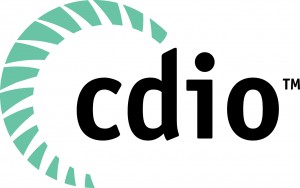Visiting a massive campus building under construction in an extensive technology park which is under development at the same time. Understanding the impact of CDIO thinking on the development of Skoltech. Discussing a career development framework that has an accent on education. Upgrading the CDIO framework to also contain training students about innovating products, processes and systems, when the technology itself has not yet reached the level of maturity for full scale application. And strolling over a Christmas market in Moscow mid-January. These were the ingredients for a memorable out-of-the-box meeting at Skoltech near Moscow.
Winter in Moscow

Winter and Christmas market on the Red Square (private photo)
Most of us had already been back to work after the Christmas break for at least two weeks, but the Orthodox Christian community in Russia had just celebrated Christmas ten days before our arrival. It made the meeting special: Christmas trees, an abundance of illumination and decorations in the streets and shopping malls, ice sculptures, a skating rink on the Red Square, very few tourists and a winterly snow-covered city. The CDIO European Region had invited us for an “out-of-the-box” meeting. The venue of the meeting was a temporary Mendeleev building of the Skoltech Institute of Science and Technology. You get an impression of the lively atmosphere and discussions at the meeting in this video on YouTube. The main campus building is still under construction but was accessible for us in a special guided tour.
Skoltech as a pivot for innovation and economic development
Founding president of Skolkovo, MIT professor Ed Crawley addressed in his keynote the lessons learnt from “the human drama to develop and build a Russian innovation and research focused technical university from scratch.” He headed the institute from its founding in 2011 till February 2016. Of course it had been a once-in-a-lifetime opportunity to get the freedom to align the development of the educational programmes with the design and construction of the building and learning spaces, and recruit and shape the academic staff, right from the start. With clear expectations from the stakeholders to achieve economic development, innovation and entrepreneurship, exchange knowledge, and be a catalyst for education, research and innovation by positioning the university as the pivot in an ecosystem of industries, start-ups and institutes that are developed in parallel. The tour to the new campus showed us what he meant. The Skolkovo Technopark is the biggest technology park of Russia. During our visit the many construction cranes showed it is being developed, with the new university building as the main pivot.
Crawley explained how he had used CDIO as the leading framework not only for the curricula, but also for the physical building and the whole set-up of the Skoltech institute, where talent development (education), discovery (research) and creation (innovation) are integrated in one comprehensive programme. Interdisciplinary thinking and collaboration, entrepreneurial education and developing prototypes for proof of concepts are the main enablers for integrated learning. Where students, researchers and collaborators of the industrial site meet, exchange ideas and knowledge and cooperate in fablabs or makerspaces and the many informal social spaces, all within one and the same campus building.
Learning-by-doing has been made a key asset in the Master programmes, and learning-by-teaching in the PhD studies. PhD students deliver many student-led courses for Master students. At present Skoltech has slightly more than 100 faculty staff, 700 Master students of which 32% are female and 16% non-Russian.
The changing face of Russian higher education
In the second keynote Irina Arzhanova of the National Training Foundation discussed the impact of demographic change on Russian higher education. I don’t remember the many graphs and tables but recall the drop between 2006 and 2016 from more than 500 to 300 students per 10,000 citizens, and the drop in number of public universities from 660 to 500. She addressed the reforms in Russian higher education with respect to quality assurance and accreditation, staff professionalisation and student mobility, merely following European standards and legislation. Internationalisation is increasing, where a minimum of 1% foreign students is the minimum level, while currently almost 7% of the students in higher education is non-Russian.
Skolkovo Innovation Center tour
Skoltech Vice President for Real Estate and Facilities, Gary Wentworth, took the attendees on a tour of the massive campus, which is set to open later this year. The circumference of the annular building is 880 meters. Within the ring-shaped building there will be several well equipped laboratories, an auditorium, classrooms, maker- and lab spaces for research and education that are interconnected by broad interlocking rings and outdoor yards where people meet and collaborate. Nearly 60% of the 136,000 square-meter space will be devoted to research functions. Twelve hundred construction workers are on the site to complete the building.

Construction works at the main campus building of Skoltech (private photo)
The tour inspired the attendees. “For me, a highlight of this gathering was the discussion about engineering workspaces and the design of Skoltech’s new campus building,” said the University of Calgary’s Ron Hugo. “I enjoyed hearing the thought process people went through in designing their new work spaces, and being able to go see the new campus. It was a wonderful opportunity to hear about the architectural team’s projects and then see the nearly final product,” he added. Chalmers’ Malmqvist echoed the sentiment. “It’s been great to be at Skoltech and great to see the soon finished building, which we’ve been hearing about for quite a while,” he said. Also I chimed in: “The most impressive thing about the university was the construction work of the new university. I would really like to come back here when everything is operational and see how the integrated concept of education, research and innovation has worked out” I said.
CDIO: a paradigm shift in engineering education
In the conference coffee breaks Ingrid Burke of Skoltech interviewed the speakers and other attendees to reflect on the value of the CDIO framework and community. The full article with interviews is available at the Skoltech website.
It all began in 1999 when industry giants like Boeing and the American Accreditation Board of Engineering and Technology rallied in favour of engineering educational reform. “In an era of unprecedented technological advancement, engineering practice continues to evolve but engineering education has not changed appreciably since the 1950s. This schism has prompted industry, government, and other key constituents to question the relevancy and efficacy of current programmes,” began a 1999 paper written by representatives of aerospace giants Boeing and TRW, Inc.
It was about this time that Crawley entered the scene. “CDIO started as a programme for four universities. There was never any intention at the beginning to go beyond those four schools,” Crawley said, referring to MIT as well as Swedish institutions Chalmers University of Technology, Linköping University and the Royal Institute of Technology. But word of the initiative spread, attracting the attention of universities far and wide. It was this unexpectedly widespread interest that inspired the founding members of CDIO to establish the list of 12 educational Standards that define the initiative today”. In his keynote he said he would like to rephrase the Standards into “Effective Practices”. The standards strive to define the philosophy of the CDIO programme, and to help educators implement educational reform. They fall into five categories:
- philosophy
- curriculum
- design-implement experiences and workspaces
- teaching and learning
- assessment and evaluation
 Malmqvist does not believe that any of the principles is particularly superior. Rather, he believes it is imperative to implement them as a set in its entirety. “It’s the set that is important. When we have worked with a set of standards, we have gotten a systematic approach to designing our programmes, and that takes into consideration many things. So in many cases it’s really working with the whole set, which is the key point. All of them are important in their own right, but they’re even stronger as a combined set,” he said.
Malmqvist does not believe that any of the principles is particularly superior. Rather, he believes it is imperative to implement them as a set in its entirety. “It’s the set that is important. When we have worked with a set of standards, we have gotten a systematic approach to designing our programmes, and that takes into consideration many things. So in many cases it’s really working with the whole set, which is the key point. All of them are important in their own right, but they’re even stronger as a combined set,” he said.
Asked why the 12 Standards seem to be so broadly embraced by geographically diverse engineering schools, Crawley explained: “I think they’re just a codification of what’s more or less generally acknowledged as good practice. The hard thing is not to get people agree that the CDIO principles are good principles; the hard thing is to convince people to go to work in the morning and do it.” In that interview I added in a similar vein, “CDIO is really not a theoretical network; it’s a network of common sense. If you’re really thinking about what education should be, you end up with a CDIO-type of framework.” Notably, I myself at TU Delft discovered CDIO after having reconstructed my Bachelor programme in Aerospace Engineering that perfectly mirrored the initiative’s guiding philosophy.
The Standard “Integrated learning experiences” champions the integration of disciplinary and practical knowledge along with personal and interpersonal skills. Personally I consider this both the most important and the most challenging of the CDIO Standards to implement. “All of the experts are discipline-based, and each of them believes that their discipline is the most important thing in the universe. If you tell them they have to enrich that with creativity, ethical, systems thinking or other interdisciplinary skills, they find it extremely difficult because they themselves are not equipped for that”.
With the permission of Skoltech, I have copied some sections from the article “Skoltech hosts CDIO meeting aimed at revolutionizing engineering education” by Skoltech correspondent and editor Ingrid Burke. The full article with CDIO interviews is available on the Skoltech website.
My next blog post will discuss the contributions of 4TU.Centre for Engineering Education at the conference, about a career development framework that has the accent on education, and an upgrading the CDIO framework to also contain training students about innovating products, processes and systems when the technology itself has not yet passed the threshold for full scale application.



